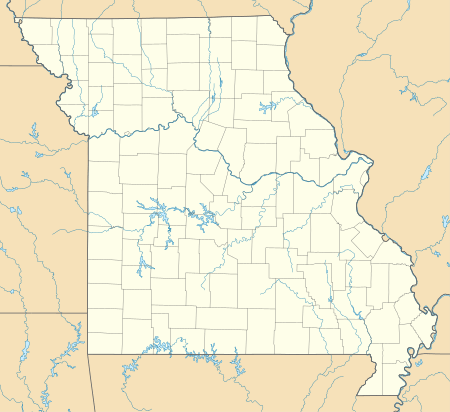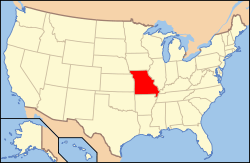Nebo Hill Archeological Site
Nebo Hill Archeological Site is a large hill a few miles southwest of Excelsior Springs, Missouri. It has the highest elevation in Clay County. One source states the hill is named after the family who owned the property in the 1900s,[2] while according to another source the name is a transfer from Mount Nebo in Jordan.[3]
Nebo Hill Archeological Site | |
Archaeological Survey of Missouri No. 23-CL-11
| |
 | |
 | |
| Location | Liberty, Missouri |
|---|---|
| NRHP reference No. | 71000465[1] |
| Added to NRHP | March 4, 1971 |
Archaeological findings
The hill is now a large archaeological site, with several ancient Native American artifacts having been found there. This ancient culture has been named the Nebo Hill culture.[2]
The ancient peoples lived along Fishing River, a tributary of the Missouri River. The culture flourished from 3,000 to 1,000 BCE. Their distinctive spearhead and axe designs, now known as the Nebo Hill axe, have been found as far north as Canada.[2] There have also been many pottery findings.[4] Artifacts from the Nebo Hill culture have also been found at the Renner Site near Riverside, Missouri.[5]
The Nebo Hill culture is a Late Archaic culture, and it is thought to be the ancestral to the later Kansas City Hopewellian culture.[6]
References
- "National Register of Historic Places-Missouri(MO), Clay County". Retrieved 2010-01-25.
- "The Archaic Period". Fishing River. FishingRiver.com. Retrieved 2011-05-15.
- "Clay County Place Names, 1928–1945 (archived)". The State Historical Society of Missouri. Archived from the original on 24 June 2016. Retrieved 21 September 2016.CS1 maint: BOT: original-url status unknown (link)
- http://associations.missouristate.edu/mas/programs/potterybrochure.pdf Archived July 14, 2010, at the Wayback Machine
- "Renner-Brenner Site Park". GaryBrenner.com. Retrieved 2011-05-15.
- "KANSAS CITY HOPEWELL". Archived from the original on May 30, 2010. Retrieved January 26, 2010.
External links
- Griffin, James B.; Morse, Dan F. (April 1961). "The Short-Nosed God from the Emmons Site, Illinois". American Antiquity. Society for American Archaeology. 26 (4): 560–563. doi:10.2307/278753. JSTOR 278753.


